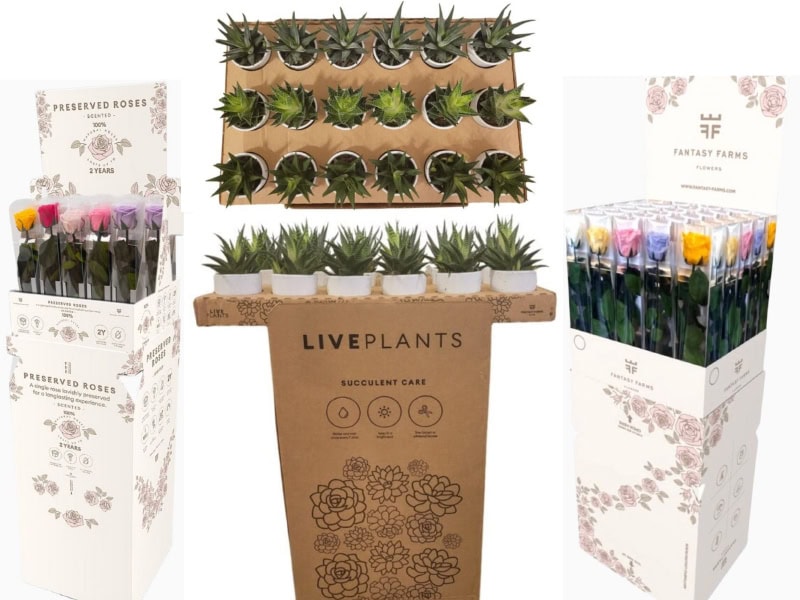Fantasy Farms and Fintech: A Blooming Success

Each year, Fantasy Farms grows more than 50 million stems of flowers across its own farms and by working with qualified growers in Colombia, Costa Rica, Ecuador, and Mexico. The company regularly supplies 8,000-plus retail locations and 30,000-plus locations during major holidays.
The Customer
Fantasy Farms is a sustainable agriculture company specializing in organic produce, heirloom fruits, and eco-conscious farming practices. With a focus on community-supported agriculture, it delivers fresh, locally grown food directly to consumers and regional markets.
The Provider
Fintech, a business solutions provider based in Tampa, Florida, offers scan-based trading (SBT) capabilities tailored to retailers and their suppliers, among other solutions.
One reason for Fantasy Farms’ success is its partnership with Fintech, a business solutions provider, which leverages their expertise and solutions in scan-based trading (SBT).
In the SBT model, ownership of a product transfers from the supplier to the retailer only for that brief period—in many cases, mere seconds—between when an item is scanned at the checkout counter and the customer pays for it.
While it’s not without risk, Fantasy Farm’s use of SBT, along with direct-store-delivery (DSD) and solid logistics, has been key to its growth.“We’re happy with the decision that we’ve made,” says Daniel Sabogal, chief executive officer and founder of Fantasy Farms.
Fresh flowers, which are Fantasy Farm’s core product, require tons of care in growing and shipping. They’re vulnerable to weather events and any breaks in the cold chain.
To minimize the risk of mishaps in transit, Fantasy Farms has partnered with a shipper to use a direct-store-delivery arrangement, in which the flowers move directly from the company’s farms to the stores where they’ll be sold. Shipments can reach any ZIP code in the United States, including within Alaska and Hawaii, between 48 and 72 hours after the flowers are harvested.
Fantasy Farms’ packaging keeps the flowers hydrated and as protected as possible while they’re in transit. Once the flowers reach a store, the packaging converts to a small, disposable point-of-sale display.
Risky Business
Even once the flowers arrive at their retail destinations, the risks don’t stop. Store employees may neglect to follow the display instructions or may place the display where it’s not as visible as it could be. “A combination of so many risks are associated with the nature of the product,” Sabogal says.
It may initially seem counter-intuitive that Fantasy Farms would decide to shift to a scan-based trading program. However, the SBT arrangement offers the company a way to differentiate itself from its competitors. “It is a matter of doing SBT in the most educated way possible,” Sabogal says.
When Sabogal started Fantasy Farms about 25 years ago, he employed a more traditional business model and served both wholesalers and traditional grocery stores. About a decade ago, Sabogal wanted to innovate and add more value for his customers, while also putting some distance between Fantasy Farms and its competitors.
He met representatives from Fintech at a trade show. When they brought up the concept of scan-based trading, Sabogal was skeptical. “I looked at them and thought, ‘Why would we ever do such a thing?’”
However, Sabogal and his team came to realize that SBT could help them gain access to more clients and develop a competitive edge. “Through their partnership, we started servicing some convenience stores and then the business grew,” Sabogal says.
The primary benefit to retailers who participate in an SBT arrangement is obvious: they free up capital because they own the products they’re selling for, in some cases, a few seconds. Inventory has traditionally been one of the largest expenses for many retailers, says Mark Landgren, Fintech’s senior vice president and general manager, SBT.
Getting into the Details
What do suppliers gain? Access to point-of-sale data, in real or near real time. The data often is more detailed than what they otherwise might obtain, including sales per store, per day, and per stockkeeping unit (SKU).
This information allows a company that sells, for instance, greeting cards—one of the first products SBT was used for, Landgren says—to quickly see which designs are hot sellers and which are moving more slowly, by store. It then can adjust the amount of each design it delivers to each location.
Previously, suppliers might have obtained similar information one or two months after a sale was completed, says Tad Phelps, chief executive officer of Fintech. At that point, it’s difficult to use the data to adjust operations and inventory levels in ways that can boost sales and cut waste. With SBT, suppliers get “headlights into the data in a much more timely manner,” Phelps says.
This detailed and timely sales information is particularly helpful for products such as flowers, which have a life span of seven to 14 days, Landgren says. It helps Fantasy Farms determine how many of each plant and color to grow, and then which bouquet mixes are most likely to sell in different locations. Fantasy Farms can use this information to minimize waste and boost sales, benefiting both itself and its retail partners.
In addition, it’s not uncommon for suppliers using SBT to be paid as their products are sold, Landgren says. For a perishable product like flowers, this could mean suppliers are paid within days. In contrast, some retailers are delaying other supplier payments out to several months.
How It Works
The Fintech SBT platform is mapped to each retailer’s point-of-sale (POS) system so it can access daily sales data. At a minimum, this data needs to include the UPC, store number, item cost and date. Fintech has connected to more than 150 retailers and a multitude of POS systems.
Once the Fintech SBT platform has accepted the daily POS data from the retailer, it populates it within a proprietary database that suppliers can use. They can set up automatic daily transfers of the data in a format they can move into their own systems, to view inventories and sell-through information. Suppliers that don’t have a system that will accept this information can log into Fintech’s portal to view and/or download reports.
Launching the Fintech SBT solution typically doesn’t require a great deal of IT resources, Landgren says. The solution is cloud-based and can be accessed from just about anywhere.
A Phased Rollout
Fantasy Farms launched its SBT program with a limited rollout with one of its convenience store clients. “That led to a complete shift in our business,” Sabogal says. Now, the SBT operating model, along with direct-store-delivery, is core to Fantasy Farm’s success.
It hasn’t always been an easy change. Initially, Fantasy Farms’ expectations regarding the volume of product that would sell-through, as well as the prices and cost structures, were not realistic, Sabogal says. In part, this was because the sell-through quantities Fantasy Farms was accustomed to when working with larger grocery stores were different than they would be at convenience stores.
Particularly with convenience stores, shipments can’t be too big, or it’s likely that some inventory will go to waste. Yet if they’re too small, logistics costs as a percentage of the overall expense will jump. In some cases, logistics can account for 50% of costs.
“It was a steep learning curve,” Sabogal says, adding that the company had to tweak its initial model. As Fantasy Farms became more adept with direct store delivery and scan-based trading, it has been able to develop a business model that is difficult for many competitors to replicate.
After starting with a few hundred stores, Fantasy Farms now uses SBT with thousands of locations. Sabogal and his team can analyze the data to tell, for instance, how sales of roses compare to sales of mixed bouquets, or how well yellow roses are selling. “We can tweak all of these variables and then start to see trends that maximize sales and our margins,” Sabogal says.
Using the data helps mitigate the risk inherent in the SBT business model by helping Fantasy Farms grow revenue at store level, minimize shrink, and control costs.
Adding Complementary Products

Fantasy Farms’ use of scan-based trading and direct-store-delivery has allowed it to expand its offerings by streamlining in-store operations for retailers. In addition to fresh flowers, the company now provides chocolate-covered fruit and baked fruit chips.
As Fantasy Farms has become adept at SBT, as well as direct-store-delivery, and because it handles many tasks the stores otherwise would have to handle, like configuring displays, it has been able to add complementary products in the outlets it’s already serving. Along with fresh flowers, Fantasy Farms now offers preserved roses, which can remain in the stores for several months, rather than a week or so. It also offers chocolate-covered fruit and baked pineapple, plantain, and other chips.
Recently, Fantasy Farms began using an artificial intelligence solution that analyzes sales data, looking for trends. It then identifies opportunities based on those trends, as well as red flags for products that are not selling well in particular areas or chains. This enables the company to forecast and plan for demand even more precisely.
Through Fantasy Farm’s vertical integration, its packaging solution, its expertise in scan-based trading and relationship with Fintech, and its use of direct-store-delivery, Sabogal says, it has gained a strong competitive edge.
Tech Partnership Sprouts Growth
The Challenge
Identify a strategy that adds value to Fantasy Farm’s retail customers and provides a competitive edge.
The Solution
Partner with Fintech to leverage its scan-based-trading technology, and with FedEx on a direct-store-delivery arrangement.
Results
Fantasy Farms’ customer base has grown to more than 8,000 locations regularly, and it can top 30,000 locations during holiday seasons.
Next Steps
Fantasy Farms has begun working with an AI solution to forecast and plan for demand with even greater accuracy.
